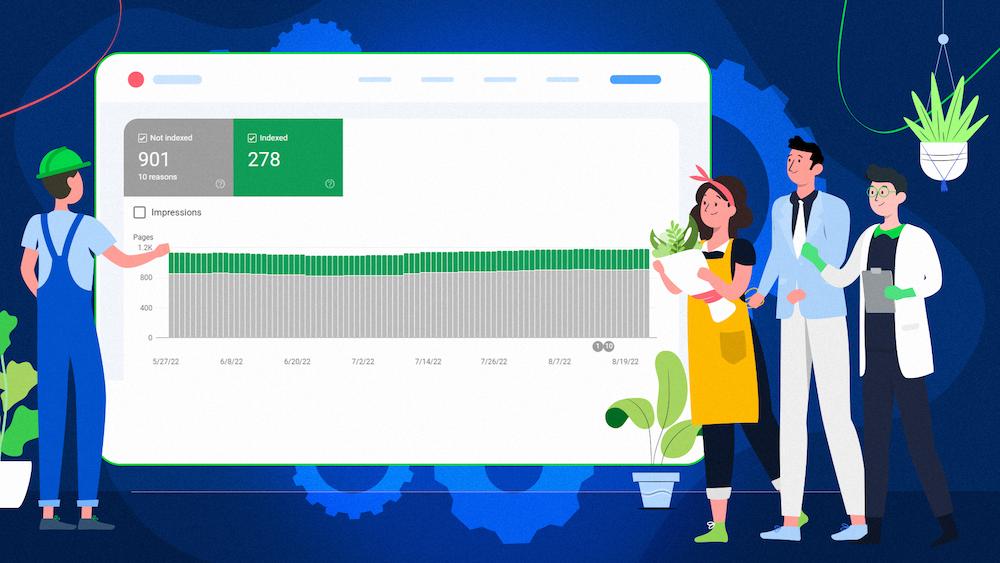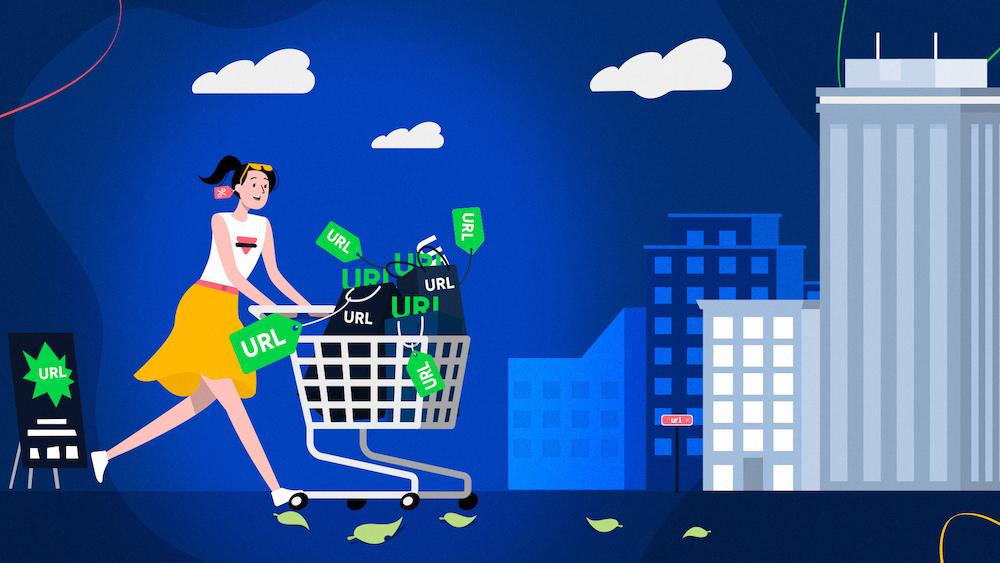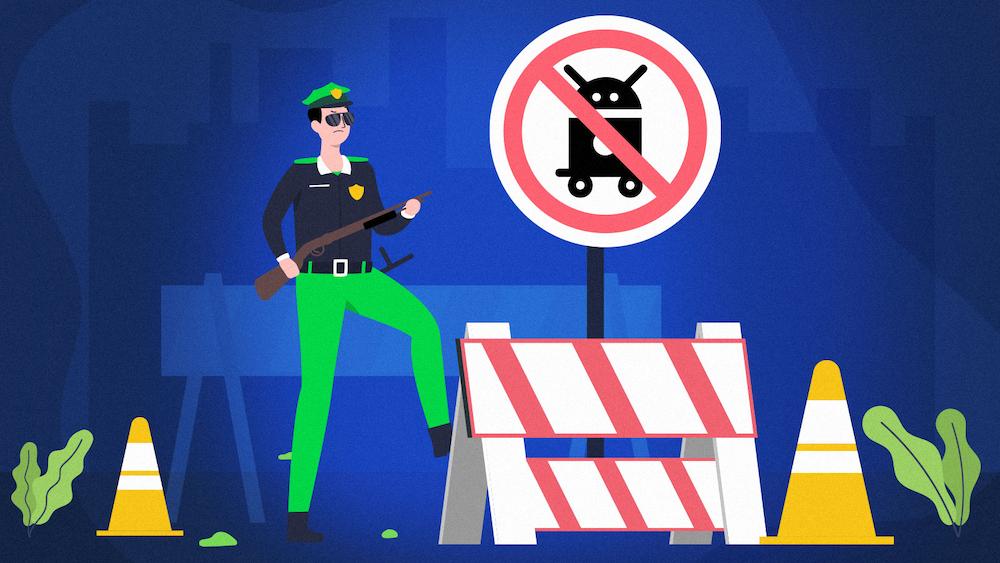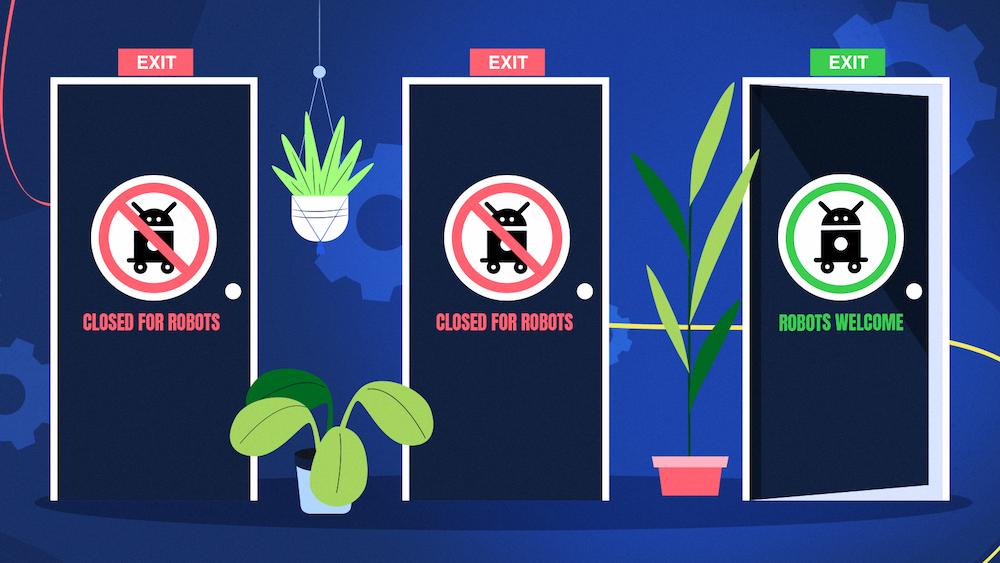The URL removal tool is a feature of Google Search Console that you can use to temporarily remove a page from Google.
Remember that the URL removal tool doesn’t deindex your URL from Google but hides it from users in search results. That’s why if you’re a website owner, you shouldn’t consider using the URL removal tool as a long-term method of removing your pages from Google.
Let’s dive into how to use the URL removal tool to ensure a healthy indexing strategy for your website.
When to use the URL removal tool
The URL removal tool is beneficial when:
- You need to remove a page urgently. The URL removal tool removes a page from search results in around 24 hours. That’s why you can use it when, e.g., you posted sensitive information by mistake, or your site was hacked, and you want to remove pages from search immediately.
- You want to remove a large number of pages. It might take a while for Google to crawl a large number of pages and notice that you, e.g., added the noindex meta tag (HTML tag specifying that you don’t want a page to be indexed.) You can quickly remove these pages with the URL removal tool without waiting for Google to crawl them.
- You changed your content and don’t want the outdated information to appear in the description snippet. The URL removal tool allows you to clear cached URLs, which removes the description snippet until the pages are crawled again.
- You don’t have access to your website’s code or server. The URL removal tool allows you to remove a page easily in Google Search Console without writing code or configuring your server.
- You want to monitor whether your pages were reported as outdated or adult content. In the URL removal tool, you can see if someone requested to remove your pages and act quickly, e.g., to update your content.
How to use the URL removal tool
You can access the URL removal tool in Google Search Console by clicking on the ‘Removals’ section on the sidebar.
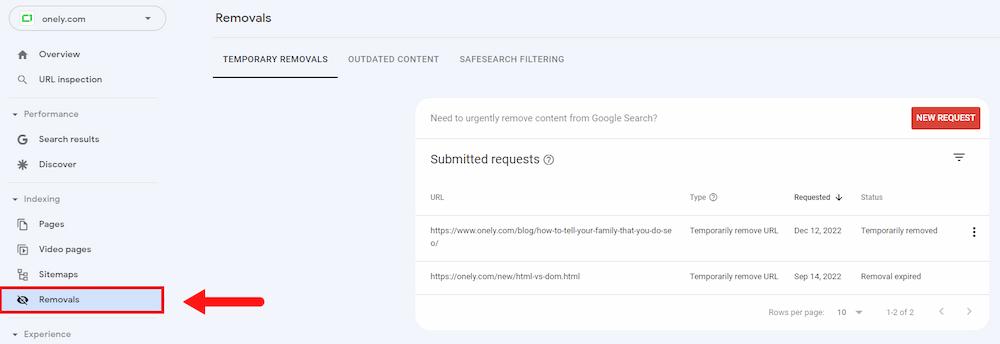
According to Google’s official documentation, while blocking a page with the URL removal tool, you should also see the information about the removal as the “Blocked by page removal tool” status in the Page indexing report.
However, even though I used the tool to block one of our archive articles, I couldn’t find the status in our Page indexing report. Can you see it in yours? Let me know in my Twitter thread.
Depending on who requested the removal and why, you may find the information about the affected URL in different tabs in the tool.
Therefore, the URL removal tool is divided into three sections:
- Temporary Removals,
- Outdated Content,
- SafeSearch Filtering.
The Temporary Removals section
If you can find a given URL in the Temporary Removals section, it means that:
- your page has been indexed,
- you requested the temporary removal of the affected page via the URL removal tool as a site owner or an authorized Google Search Console user, so
- the page can’t be now found on Google.
In the Temporary Removals section, you can temporarily remove URLs, clear cached URLs, and see a history of your removal requests from the last six months.
Temporarily Remove URL
The Temporarily Remove URL option removes your page from Google’s search results for six months.
Keep in mind that the URL removal tool doesn’t remove this page from its index but, according to John Mueller, “it’s like a filter for the display in the search results (…).”
And essentially, what happens is we don’t remove it [the requested page] from our index. So the whole indexing side stays the same. The crawling side stays the same. We just don’t show it in the search results.
To remove a page from the index, you need to implement additional methods, e.g., the noindex meta tag. Otherwise, the page can automatically re-appear in search results after six months.
Additionally, Google continues to crawl the removed pages. To block access, you need to add a disallow directive in robots.txt, a text file specifying which pages search engine bots can and can’t crawl.
Clear Cached URL
The Clear Cached URL option removes the page description snippet in Google Search results until the page is crawled again. Until then, the description snippet says, “No page description available.”
How to specify a URL in the URL removal tool
The Temporary Removal section enables you to remove:
- an individual URL,
- a group of URLs with the same prefix.
For the sake of testing, I submitted one of our archived articles through the URL removal tool.
Within the tool, I clicked on ‘New request’ and entered the URL I wanted to remove from SERPs temporarily.
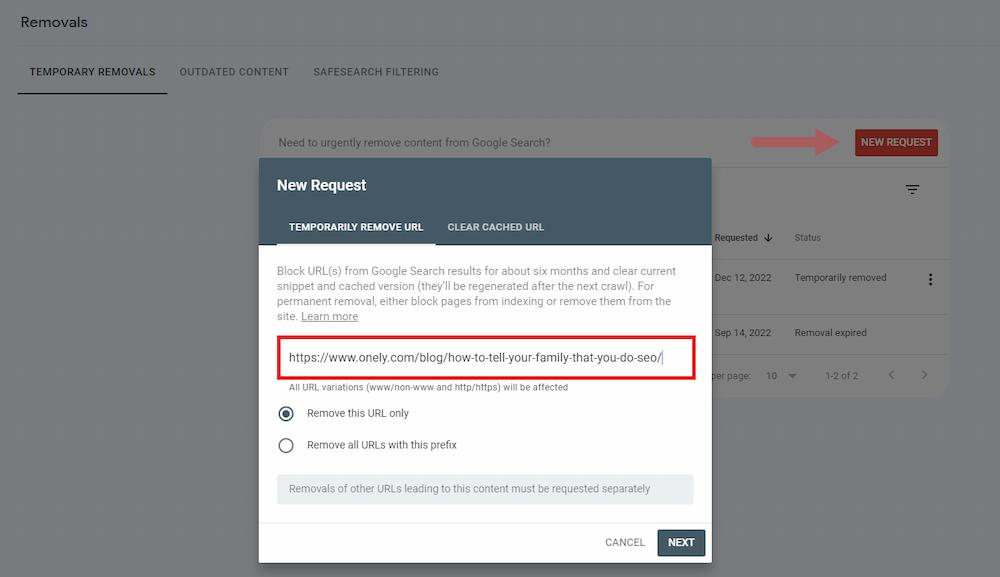
When blocking an individual URL, you need to enter the exact URL that appears in search results — variants like example.com/page and example.com/Page are treated as two different URLs.
However, the URL removal tool affects all variations like www/non-www and HTTP/HTTPS. That’s why you shouldn’t use this tool to specify which version of your URL you want to appear in search results. If you want to remove only one version, use canonicalization methods, e.g., canonical tag (HTML tag specifying which page is the main one when more than one version exists).
If you want to block multiple URLs, define their prefix. For example, if you specify ‘blog/’, all URLs inside that directory will be removed (blog/page1, blog/page2, etc.)
You need to be extra careful when removing multiple URLs at once to avoid mistakenly removing a valuable page. Double-check if there are any important pages with the prefix you’re planning to remove and monitor any potential drops in organic traffic after using the tool.
According to Google’s official documentation, removing a given URL from search results should take about a day. You’ll see the submitted URL as ‘Pending’ in the URL removal tool during this time.
When successfully removed, the status of the URL in the tool will change to ‘Temporarily removed.’
Remember that using the URL removal tool only removes it from SERPs, so users can’t find it when browsing for your content.
To double-check if the removed page can be found on Google, I copied a fragment of the removed article and used the site: command.
As you can see, there’s nothing to find, which means my request worked correctly.

But remember that the tool doesn’t make a submitted page deindexed. If you check that page in the URL Inspection tool, you’ll see it’s still in Google’s index.
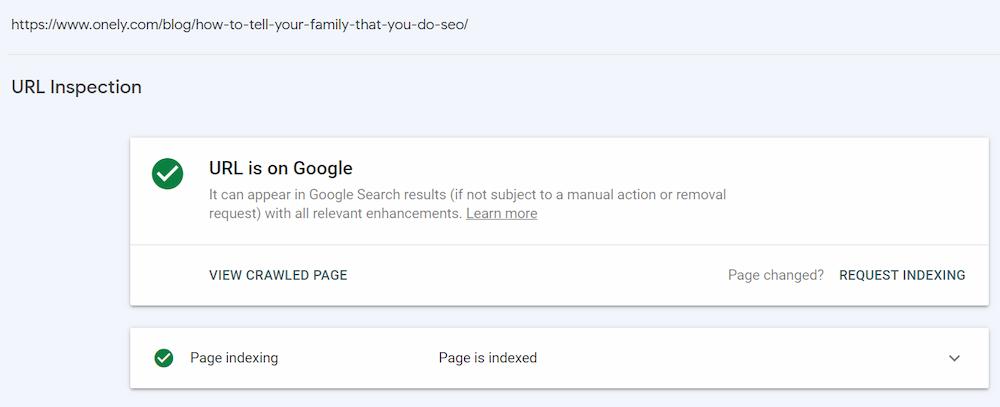
When you decide on using the URL removal tool, make sure that you follow the best practices on when you can use it. For example, don’t try to request the removal of pages returning 404 or 502/3 status codes. As Google can consider these URLs gone, your request may expire.
History of removal requests
You can see the history of your removal requests made within the last six months. It shows you the type and date and current status.
Your request can have one of the five following statuses:
- Processing request – Google usually takes up to a day to remove a URL.
- Request denied – your request can be denied when the page is not indexed or another identical request is in progress.
- Request canceled – you canceled the request, and the page should reappear in search results again.
- Temporarily removed – your request was approved, and Google removed the URL from search results.
- Removal expired – your request has expired, and the page can appear in search results again.
- Cleared – Google cleared the cached URL.
How to cancel a request
If you want the page to return to SERPs, ensure you update the content before the removal expires.
Because after six months from making a request, the page should automatically re-appear in search results.
However, if you troubleshoot all the issues before the removal expiration date, you can manually cancel the removal.
Here’s how to cancel a request in the URL removal tool:
- Open the Temporary Remove URL section.
- Click on the menu button next to the request you want to cancel.
- Select the ‘Cancel request’ option.
And that’s all! The page should be able to appear in Google Search again soon.
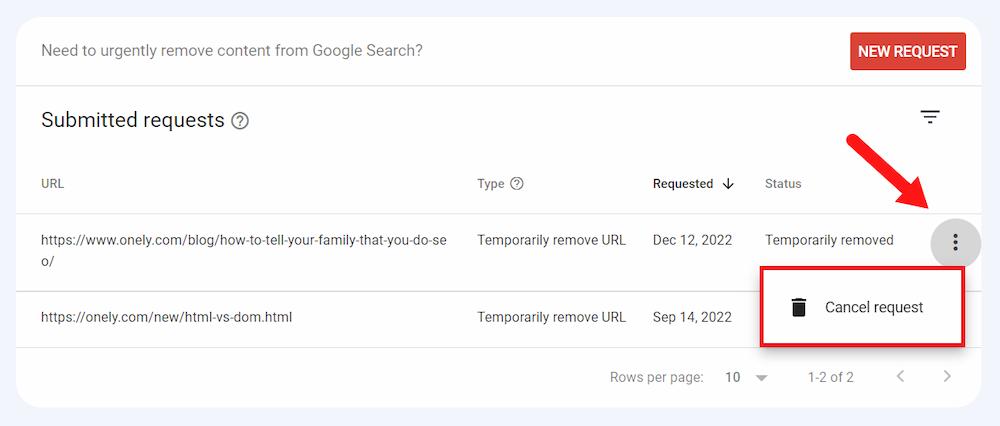
However, there is no official information on how long it takes for Google to cancel a request. In one of his tweets, John Mueller mentioned that the requests are “processed pretty quickly.”
Canceling a removal request is usually processed pretty quickly, and it looks like the site is back now, awesome!
I decided to check what exactly “pretty quickly” means.
To test how long it takes to cancel a request, I performed the following steps:
- I used the URL removal tool to remove three of our pages from search results.
- I waited for Google to remove these pages from search results.
- After Google approved my requests, I used the ‘Cancel request’ option and monitored how long it took to process them.
It turned out that all three pages were back in search results in less than 4 hours!
In general, when the removal expires, Google may put it back into the SERPs without any action on your side.
However, if it didn’t happen, you can request the reindexing via the URL Inspection tool.
In the tool, click the ‘Request indexing’ button so Google will recrawl your page, and if it still finds it valuable – it will leave it in the index and show it in the SERPs again.

How to make a removal permanent
The URL removal tool provides only a temporary solution. If you want to deindex your page for good, here are three things you can do:
- Add a noindex meta tag
The noindex meta tag indicates that you don’t want a specific page to be indexed.
Search engine bots discover the noindex tag while crawling the page, and if they respect it, they won’t index it. The page will remain accessible on your website to both search engine bots and users but won’t appear in search results.
Find out more about the noindex tag in this article.
- Set up a 404/410 HTTP status code
When you don’t want to update your content and think that the page no longer belongs to your business and indexing strategy, feel free to remove it from your domain.
Implementing 404 and 410 HTTP status codes removes a page from your site. As a result, search engine bots and users won’t be able to access your page.
When successfully set up, the affected pages should also change their statuses in Google Search Console accordingly to “Not found (404)” or “Blocked due to other 4xx issue.”
Having 404 pages on your website? Read our article to learn how to build a custom 404 page for your business.
Add a password
Search engine bots are not able to access a page if a password protects it. It’s a good solution if you want to secure sensitive information on your page.
But watch out: sometimes, you may want your password-protected pages to be visible in SERPs. Read Ania Siano’s article to learn how to approach this issue.
The Outdated Content section
The Outdated Content section shows you when someone reports your content as outdated through the Remove Outdated Content tool.
Google recommends using the Remove Outdated Content tool when a page no longer exists or the owner has removed critical content. Google users can request one of the two types of removal:
- Outdated page removal – used when the page no longer exists. If the request is successful, Google will remove the page from its index.
- Outdated cache removal – used when the page exists, but some content has been removed. If the request is successful, Google will no longer show the page for queries related to the removed content.
If someone reports your content as outdated, you can monitor the request’s status in the URL removal tool. There are seven possible statuses:
- Approved – the user’s request was successful, and your page will be removed from the index, or Google will no longer show it for queries related to the removed content.
- Denied: Content still on the page – Google won’t take any actions against your page because the reported content is still on the page.
- Denied: Outdated content not in the index – reported content is not in the indexed version. You might have removed it already, or the user entered incorrect content.
- Denied: Page not indexed – the page reported by the user is not indexed.
- Denied: Page not removed – the page reported by the user still exists.
- Denied: Duplicate request – the same request is already being processed.
- Denied: Unspecified – the user’s request was denied for other, unspecified reasons.
You can’t take any direct actions in the URL removal tool to stop the process. However, it’s still worth monitoring the requests. If some of your content is indeed outdated, you can update it or remove it from your website.
The SafeSearch Filtering section
Users who have the SafeSearch filter on don’t see pages considered adult-only. However, if they think some page made it through the filter, they can report it in the SafeSearch suggestion tool.
In the SafeSearch Filtering section, you can see the history of requests users made and the status of each request:
- Processing request – Google is processing the request,
- Request canceled – users canceled the request on their own,
- Request denied – Google decided the content shouldn’t be considered adult-only,
- Filtered – Google approved the request and won’t show the page to users using the SafeSearch filter.
If the request was approved, but you think it’s incorrect, you can report it in the Webmaster Forum.
Here’s what you can do now: Still unsure of dropping us a line? Read how technical SEO services can help you improve your website.NEXT STEPS
Wrapping up
I hope that after reading the article, you know how and when to use the URL removal tool. Here are the key takeaways to keep in mind while using the tool:
- The URL removal tool doesn’t deindex the page. It just removes it from Google’s search results as requested to be removed by a website’s owner or visitor.
- Google continues to crawl pages removed with the URL removal tool. If you want to block it from crawling, you need to disallow crawling in robots.txt.
- The URL removal tool removes both www/non-www and HTTP/HTTPS versions from search results.
- To remove a page permanently, you need to implement additional methods, e.g., the noindex meta tag, 404/410 HTTP status code, or add a password.
- If you want to remove more than one URL, double-check all URLs that will be affected to prevent accidentally removing an important page.
- Regular monitoring of the Outdated Content and SafeSearch Filtering sections allows you to take action quickly if any of your pages were reported (e.g., update your content or report it if you think the request was incorrect.)
Need help controlling your indexing strategy? Contact us to work out a sound plan for what of your pages should be indexed and visible in SERPs.

Hi! I’m Bartosz, founder and Head of Innovation @ Onely. Thank you for trusting us with your valuable time and I hope that you found the answers to your questions in this blogpost.
In case you are still wondering how to exactly move forward with your organic growth – check out our services page and schedule a free discovery call where we will do all the heavylifting for you.
Hope to talk to you soon!


